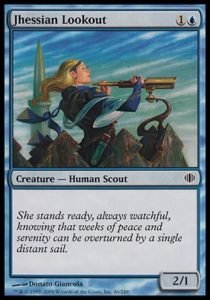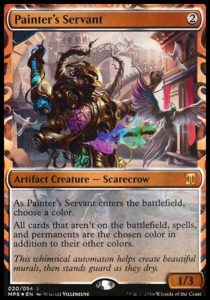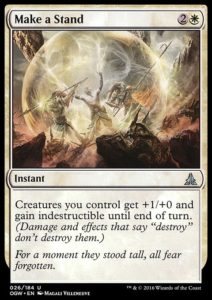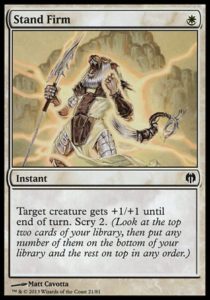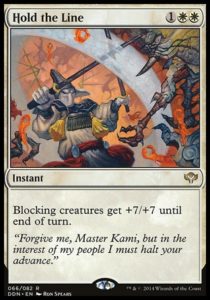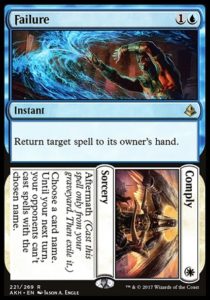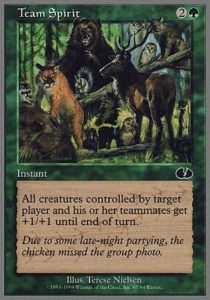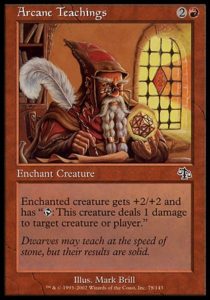Dominaria released on Friday, and it has already had an enormous impact on Magic. It’s dramatically altered the face of Standard, fostered a very different Limited environment from everything we’ve seen lately, enjoyed the largest prerelease in history (apt), and faithfully returned to Magic’s past while placing it firmly within modern design sensibilities.
I spent all of last week learning everything I could about Dominaria Limited to prep for Grand Prix Columbus. My team finished 24th, which was exactly good enough to for cash and a pro point. Our research paid off: we beat some of the best players in the world, had a solid game plan to attack the format, and were eager to learn more as we played. I’d like to talk about what we thought, what we learned, and what was most notable at the GP. This won’t be a tournament report in the strict sense, but I will report on a bunch of stuff at and around the tournament.
Initial Impressions
Team Sealed is an interesting beast. Sealed is generally slower than Draft because players have access to more rares but tend to have less streamlined decks. However, Team Sealed gives you twice as many packs, providing sufficient resources for decks to more closely resemble the speed and sleekness of Draft rather than the slower clunkiness of Sealed. Of course, with twelve packs, practically every single bomb is going to be played, and with Dominaria being stacked with bombs from mythic to uncommon, that means you should expect a lot of must-answer cards in every matchup. Dominaria Team Sealed is particularly difficult because you want to play every single bomb, and there are oh so many bombs (many of them multicolor) but hardly any fixing.
The format is slow. Most of the aggressive creatures have problems getting past 1/3s, and there are three outstanding 1/3 common Wizards in Vodalian Arcanist, Caligo Skin-Witch, and Ghitu Chronicler that can blunt aggro while providing value in the slower matchups. The lack of cheap, powerful combat tricks or common anthem effects (Charge is no Sanctified Charge) and abundance of lackluster aggressive creatures makes aggro hard to build. The abundance of excellent removal in black, blue, red, and green, as well as the preponderance of powerful Disenchant targets makes Dub an incredibly dangerous play. Finally, a large portion of the common creatures are weak and easily blanked, blocked, or killed. All of this serves to make the format grindy and defined by ridiculously powerful bombs.
Color Balance
The obvious archetypes to look for are blue-red (where you can leverage Academy Journeymage and Ghitu Chronicler best), black-green (where you splash all the bombs you can that don’t fit in the other decks), and something with white. I hadn’t quite figured out what to do with white, since all of its creatures want to go wide (which has few rewards at common) and attack (which is hard to do profitably). Usually, black is deep enough to be splashed by one of the other two decks, and there might be enough artifacts and historic-matters cards to give to the white decks. It turns out that other people approached the format from the opposite direction as me (they thought white was the best color), but funnily enough, they also came to the conclusion that the obvious archetypes to look for are UR, BGx, and Wx.
The most important common in Team Sealed is Skittering Surveyor. Yes, Eviscerate is better, but there are other common removal spells; you can’t replace Skittering Surveyor. This little artifact creature is the linchpin in your greedy three color (probably Jund) deck or to give your blue deck better mana.
Standout Commons
Call the Cavalary and Jousting Lance were the key cards to our white decks. I know, 2/2s for two are bad in the format, but a pair of ’em get past a 1/3 and they wear equipment incredibly well. Most creatures have no more than four toughness, so a 4/2 first strike (or a 2/2 with a combat trick) is a fierce attacker.
Llanowar Elves was consistently disappointing. Unlike Vodalian Arcanist (which has a relevant body and creature type) and Elfhame Druid (which produces prodigious amounts of mana and can block saprolings), Llanowar Elves has awful stats. Ramping into three or four drops a turn early isn’t incredibly potent—it’s best at letting you kick spells early, but when you’re trying to get to 6+ mana sources, you’re probably getting there just as fast by just making your land drops. Lastly, it makes your opponent’s Fungal Infections great, when they’re normally going to be pretty bad (unless you’re playing white, you almost never want to have X/1s in your deck).
I know I mentioned it before, but Vodalian Arcanist, Ghitu Chronicler, and Caligo Skin-Witch are hugely important. They blunt aggro, enable wizard shenanigans, and all have a lot of value for control decks. If you’re playing against a black player and have the luxury of playing around Caligo Skin-Witch, you really should.
Also, she’s not a common, but Tetsuko Umezawa is insane in basically every color combination.
Lesson #1: Don’t Give Up
In round three, I faced a known good player in the tournament. I lost the die roll, mulliganed to six, kept a two lander, scried to the bottom, and missed my third land drop (having a Vodalian Arcanist and Urza’s Tome to deploy on turns two and three). My opponent curved out something like T2 Knight of New Benalia, T4 Aven Sentry, T5 Karn, Scion of Urza, T6 Lyra Dawnbringer. I won that game (Zahid, Djinn of the Lamp into Academy Journeymage on Lyra into In Bolas’s Clutches Lyra). Sometimes you’ll face seemingly overwhelming odds, but you’ll be able to find out a way out.
#2: Don’t Give Up (also, read the cards)
In round six (fresh from our first loss against a team of known good players), we played another team of known good players. It’s game one and I have a commanding lead against my opponent’s RG bigstuff deck. I’ve stolen his Grunn, the Lonely King and have been slowly attacking him down (Icy Manipulator put the kibosh on Grunn attacking). I’d stabilized at 13 life with him at five lands. When he hit his sixth land drop, I held back a Ghitu Chronicler just in case he had a Keldon Overseer in hand to steal back his Grunn and attack me for exactly 13. Turns out, this plan doesn’t work—he indeed had the Overseer, but I had to leave back two blockers because of his Icy Manipulator. He kicked Keldon Overseer, took the Grunn, and I got ready to scoop up my cards. But I didn’t—maybe he’d make a mistake. And he did! He just attacked with the Grunn and didn’t even tap down my Ghitu Chronicler. I chumped, untapped, and used the removal spell I’d not had a target for to win the game.
After the match, I asked him why he didn’t kill me. Turns out, I hadn’t read Grunn, the Lonely King very carefully. He only gets the bonus if he attacks alone. Dominarian cards have a lot of text, and it’s good to read them to make sure you remember what they do. (Can you remember everything Garna, the Bloodflame does off the top of your head? I can, but that’s just because she’s so friggin’ good.)
#3: Mistakes will happen
Last year, I bungled my way through sleep deprivation and food poisoning to a 5-1 Day Two at GP Orlando. I accepted then that I was going to make a ton of mistakes, but I wasn’t going to let that frustrate me. Everything is either within my control, or not within my control. If it’s not within my control, then there’s nothing I can do differently. If it was in my control, I ask whether the reason I had for a particular choice was well thought out or not, and then improve my decision-making trees in the future. It’s rare that I just make a dumb play, where I speed through and make a decision I don’t want to make without thinking.
Well, I made one of those mistakes on day two. I’d resolved The Mirari Conjecture, buying back a sideboarded Pierce the Sky, and then Divination. For some reason, I cast the Divination immediately instead of waiting to Fork it the following turn. I had no other spells in my hand, drew into no more spells, and got no value off the third and most important chapter of my saga. I had no good reason to do this: I was able to play around Caligo Skin-Witch. I didn’t need to dig for Blink of an Eye to get fancy. I lost that game, but might have been able to close it out if I’d drawn two extra cards at that crucial juncture. My loss sealed our fate and we were X-4.
Once it was done, it was in the past. There was no utility in being angry at myself. I resolved to do better in our final match of the day (which later turned out to be against two world champions and a player of the year). And hell, I was still having a blast playing Magic with two good friends in a sweet format. I’m not happy to have made a boneheaded play, but I’m proud of myself for not letting it derail me.
Lesson #4: It’s about the Team, not You
Too many people at GP Columbus (and other team events) said some version of the following: “Well… I’m X-0, but my team is 2-4.” This sentiment misses the point of team sealed. A team’s goal is to make three great decks (or failing that, two great decks and one serviceable deck). It doesn’t matter how good your best deck is if your other teammates can’t win their matches. If you’re playing the tournament with the mentality of “well I did my part,” well, you’re not being a team player and aren’t likely to do well. Your teammates might not need your help playing their matches,* but they definitely need your positivity and support.
*I think most in-match collaborations at team events are detrimental – they give away information, distract the pilot from their game, and defer to the expertise of outsiders (aka people who are less familiar with the decks and matchup in question).
On day one, I piloted UR Control (which seemed great and turned out to be excellent), Rich played Jund Bombs (which seemed great but underperformed), and Hugh was on GW Go-Wide (which seemed okay and dramatically overperformed). It quickly became apparent that I had our most powerful deck. If I lost my match, then our team was most likely to lose the entire match. Winning my matches wasn’t a feather in my cap, but a necessity. It certainly was enthralling when I won my matches, but I was only keeping score of how the team was doing, not myself.
On day two, we had a much weaker pool. We split it into WB, RW, and GU. I piloted the serviceable-but-unexciting blue-green deck. The expectations upon my deck were different—I didn’t have a howitzer to demolish our opponents with, but a slapdash assortment of weapons that could break apart at any second. If I lost, our best deck wasn’t falling and taking the team down with the ship. But that didn’t matter—my responsibility was the same. I had to play the best I could to win every match. My individual record was inconsequential. It was all about whether we as a team came through. That’s what everyone’s focus should be on.
Wrapping Up
Columbus is the best GP city I’ve ever been to. There was fantastic food right by the convention center, the weather was brisk and pleasant, our Airbnb was amazing, and the city was both lovely and super-walkable. I ate healthily my entire time there and snagged five tickets to Infinity War after the GP. This was my third Team GP and my first cash (and day two) at a team event. I’m super stoked for GP DC at the end of the month and look forward to practicing more Team Sealed until then.
And as always, thanks for reading.
—Zachary Barash
Zachary Barash is a New York City-based game designer. He works for Kingdom Death: Monster, has a Game Design MFA from the NYU Game Center, and does freelance game design. When the stars align, he streams Magic.
His favorite card of the month is Ghitu Chronicler. For two mana less than Archaeomancer, you get a Straw Soldiers. For two mana more, you get an Archaeomancer with one extra point of toughness. Someone, the combination of these two components yields a more powerful card than the more straightforward one. It all goes to show how powerful flexibility and Kicker are. …unless you’re playing Ghostly Flicker, then everything I just said is wrong.

